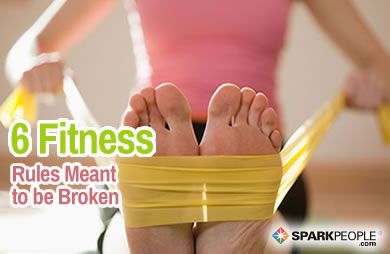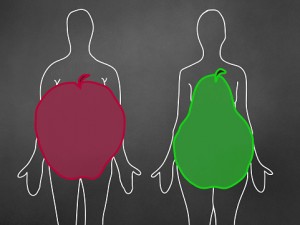Lose Weight > Common Sense To Lose Weight > Common Sense Article > 6 Fitness Rules Meant to be Broken
6 Fitness Rules Meant to be Broken
 We've already debunked some outdated diet rules, but what about fitness? Just as there is plenty of questionable diet and weight-loss advice going around, some exercise "rules" that people live by are downright misleading, misguided or just plain out wrong. Why does it matter? Because you want to make the most of your time in the gym—and stay safe while you do it.
We've already debunked some outdated diet rules, but what about fitness? Just as there is plenty of questionable diet and weight-loss advice going around, some exercise "rules" that people live by are downright misleading, misguided or just plain out wrong. Why does it matter? Because you want to make the most of your time in the gym—and stay safe while you do it.Read on as we debunk six old fitness myths and replace them with new workout rules that will support your body to be its fittest and healthiest!
Old rule: Tone up a specific area of your body by exercising it more.
You know the infomercials and workout DVDs that promise to get rid of those flabby underarms, tighten your hips or turn your stomach into an instant six-pack? Well, they fib. There is absolutely no way for you to selectively reduce fat on a specific area of the body. While you can build muscle in a particular area, you cannot get rid of the fat that way.
New rule: Burn fat for six-pack abs and jiggle-free arms.Old rule: Do crunches for a strong midsection.
Truth be told, you do have a six-pack under that stomach—you just can't see it yet if you have some pounds to lose! So instead of wasting your energy by spot training (think thousands of crunches), focus on using your entire body to burn calories through a mix of weight-training and cardio (and see new rule #3 for a powerful fat-blasting combo!). Also, be sure to eat a healthy, lower calorie diet. It's only through exercise and a proper diet that those strong muscles can be shown off!
Crunches are by far the most popular exercise for working the abs, but why? Turns out, crunches only target the top part of your abdominals and actually don't improve your core strength that much. And, really, what good is fitness if it can't help you easily do what you need to do in everyday life?
New rule: Get a strong core with functional full-body exercises.Old rule: Always rest between strength-training sets.
Did you know that abs only make up one part of your core? Yep, the full core is made up your abdominals, obliques, transverse abdominis and erector spinae (low back). Some experts even consider your hips to be part of your core. So when it comes to getting a strong midsection, don't just crunch. Do a variety of planks, side planks, twists, rotations, balance work and more to build functional strength and support your body—no matter what activity you're doing. A strong core keeps your back healthy and resistant to pain and injury, improves posture, allows you to move your body with greater control and helps with balance.
You've probably heard that you should rest for 60-90 seconds between sets when lifting weights, right? But the fitness industry has gotten a lot more creative, focused and time-efficient when it comes to weight-lifting, making this rule old news.
New rule: Circuit train to make the most of your workout.Old rule: Do lots of reps with light weights to get toned and lean, not big and bulky.
While there's nothing wrong with resting between sets, who has time? Make the most of your workout time with circuit training! Circuit training is a method of training borrowed from athletes and modified for us regular folks. Although circuit training is a broad term and can be done in many different and creative ways, traditionally circuit training is done in stations that alternate between different muscle groups. In this type of training you go from one station or exercise to the next with little to no rest, as you're working a different muscle group. Because you keep your heart rate up throughout the workout, you not only build muscle—you also get the benefits of cardiovascular training. Perfect for those with limited time to work out!
I hear this outdated rule a lot, especially from women. For some reason it has been pounded into our heads that lifting light weights makes you tiny and toned while lifting heavy weights will make you big and bulky like the Hulk. And it just isn't true.
New rule: Choose weights that challenge you.Old rule: Do yoga and Pilates to make your muscles longer and leaner.
If you can lift a weight 20 times, it's time to go heavier. Lifting heavier weights will not bulk anyone up unless they spend hours and hours in the gym, so don't be afraid to pick up the larger weights in the strength area of your health club. Depending on your weight and how many reps you're doing (SparkPeople recommends 8-15 reps with 1-3 sets for each exercise), you always need to select a weight that is heavy enough to get you to muscle exhaustion during your last couple of reps in a set. Exhaustion means your muscle has worked hard enough and is tired enough that you cannot do another rep with proper form. It's so important to reach exhaustion because it's at this point that your body starts to build more muscle. (We know how important muscle is for weight-loss!) So, if you're regularly doing bicep curls with 5-pound weights and could easily squeeze a few more reps or sets into your workout without really even feeling the burn, it's time to up those dumbbells!
This is another old rule I hear from women a lot. Truth is, yoga and Pilates don't burn that many calories per hour (less than 200 calories in an hour for a 140-pound person) and while both workouts have some muscle-strengthening benefits, they're not nearly as effective for weight-loss as other more traditional cardio and strength-training activities. Probably more important, no form of exercise has the ability to "lengthen" your muscles. Your muscles are a certain length, and training doesn't make them longer—period.
New rule: Round out your workout routine with yoga and Pilates.Old rule: No pain, no gain.
I practice yoga and Pilates workouts, but not to burn calories. I do these two mind-body practices because they reduce stress, improve focus, strengthen the core and greatly improve flexibility—all of which are very important! Yoga and Pilates are fantastic activities that add value to any workout program, but they shouldn't be a replacement for cardio or strength training, nor do they offer the same benefits of these heart and muscle-strengthening activities. Read more: Does yoga count as cardio?
I'm sure you've heard this old phrase. But nothing could be further from the truth. While "feeling the burn" is a good thing and signals that the body and its muscles are working hard, there is absolutely no gain to real pain.
New rule: If you feel bad or have pain, stop, rest and modify your workout.
If you have pain, do not take it lightly or push through it. Pain is a sign that something is wrong with your body and it needs rest or a modification of an exercise (for example walking instead of running or doing a front lunge instead of a backwards lunge). Also important, if you feel terrible, black out or have chest pains (more warning signs are here), you must take this very seriously and slow down (for cardio) or stop (for immediate severe pain). Additionally, if you've been working out very hard and feel like you might be overtraining, it's important to give your body the rest it needs. Remember, exercise is supposed to make you feel better—not worse!
When it comes down to it, the new rules for fitness are common sense and easier to stick with. Incorporate these new "rules" into your repertoire and you'll be amazed at what a difference such small changes can make!
This article has been reviewed and approved by SparkPeople fitness expert and certified personal trainer, Nicole Nichols.
Related Articles
-
Why Detox Herbs Can Make You Feel Brand New Again
The immune system is the bodys defence m
-
7 Ways to Get Rid of Stomach Fat
Getting rid of stomach fat can often be
-
You Can Lose Weight And Still Have Sugar
There are many myths about sugar. But panels of experts have found th
-
Utilizing Genuine Hoodia for Quick Real Outcomes
Hoodia diet is the most recent diet plan fad to strike the market. Wei
-
Social Networking Equals Proven Weight Loss
The problem with dieting and trying to get into better shape is tha
-
How Music Can Help You Burn More Fat
Browsing one of the Russian websites I have recently found a little a
- DON'T MISS
- Natural Weight Loss Supplements For Fat Loss
- Weight Loss Apps: Useful Or A Waste Of Time…& Money?
- Benefits of Using BMI to Lose Weight
- Quick Weight Loss Tips - Healthy Weight Loss
- What Is Real Hunger
- Acquire More Fruitful Weight Loss Benefits With A Superior Weight Loss Patch
- Strength, Power, And Wisdom
- Proactol Fat Binder For Fast And Effective Weight Loss
- Secret To Weight Loss
- Top 4 Fad Diets Unveiled




